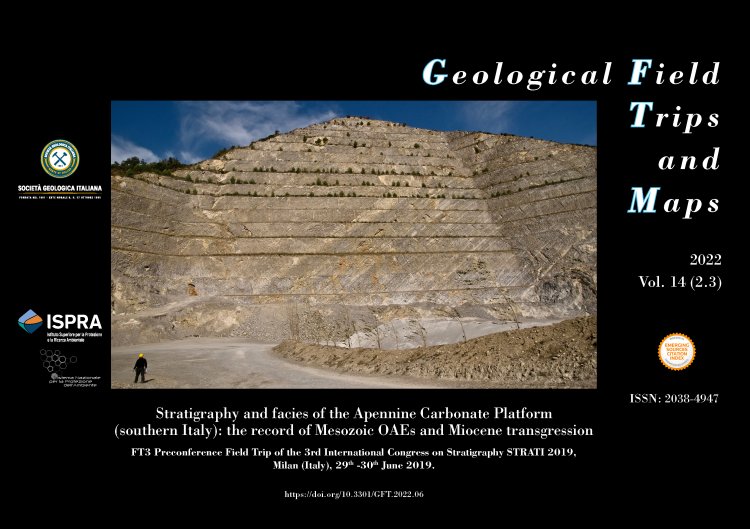
Volume 14 (2.3)/2022
Stratigraphy and facies of the Apennine Carbonate Platform (southern Italy): the record of Mesozoic OAEs and Miocene transgression
FT3 Preconference Field Trip of the 3rd International Congress on Stratigraphy STRATI 2019, Milan (Italy), 29th -30th June 2019
DOI: https://doi.org/10.3301/GFT.2022.06 - Pages: 1-74
Mariano Parente1, Sabrina Amodio2, Alessandro Iannace1 & Monia Sabbatino1,3
1Dipartimento di Scienze della Terra, dell'Ambiente e delle Risorse, Università degli Studi di Napoli "Federico II", Complesso Universitario di Monte Sant'Angelo, via Cintia 21, 80126 Naples, Italy.
2Dipartimento di Scienze e Tecnologie, Università degli Studi di Napoli "Parthenope", Centro Direzionale, Isola C4, 80143 Naples, Italy.
3present address: Eni SpA, Upstream and Technical Services, SPES Department, Via Emilia 1, 20097 San Donato Milanese (MI), Italy.
Corresponding author e-mail: sabrina.amodio@uniparthenope.it
2Dipartimento di Scienze e Tecnologie, Università degli Studi di Napoli "Parthenope", Centro Direzionale, Isola C4, 80143 Naples, Italy.
3present address: Eni SpA, Upstream and Technical Services, SPES Department, Via Emilia 1, 20097 San Donato Milanese (MI), Italy.
Corresponding author e-mail: sabrina.amodio@uniparthenope.it
Abstract
The Apennine Carbonate Platform of southern Italy witnesses nearly 150 Myr (Late Triassic to Late Cretaceous) of shallow-water carbonate sedimentation in the subtropical central Tethys. During this field trip, you will have a look at the stratigraphy and facies across some key intervals of global palaeoenvironmental perturbation and at some important stratigraphic discontinuities in the history of the platform.
During the first day, you will visit three localities of the Matese Mts. At San Lorenzello you will look at Milankovitch cyclicity expressed in Lower Cretaceous (Valanginian-Hauterivian) peritidal carbonates. At Pietraroja you will have a look at the foramol facies of the Cusano formation, marking the Early Miocene transgression on top of the eroded Cretaceous substrate. Moving north, at the Regiapiana you will see the abandoned mines that exploited the mid-Cretaceous karst bauxites, which mark a prolonged subaerial exposure. Moreover, you will walk through the Middle Miocene synorogenic history of the platform, from its exposure and erosion in the forebulge to its incipient flexural subsidence, highlighted by the Lower Miocene carbonates of the Cusano formation, to its drowning below the photic zone, marked by a phosphatic hardground overlain by the "Orbulina marls" of the Longano formation.
During the second day, you will head south toward Salerno. In a quarry at Mercato San Severino, you will look at the record of the early Toarcian oceanic anoxic event, marked by the abrupt demise of lithiotid bivalves and dasycladalean algae, the major carbonate producers of the Lower Jurassic carbonate platforms. At the base of Mt Tobenna, you will look at the Aptian Orbitolina level: a marker bed whose palaeoenvironmental meaning has been long debated. From Mt Tobenna you will move south toward Monteforte Cilento where you will look at the record of the Cenomanian-Turonian OAE2 in the Apennine Carbonate Platform.
Keywords
shallow-water carbonates, facies, cyclostratigraphy, isotope stratigraphy, oceanic anoxic events, biotic crises, southern Apennines, Italy.
